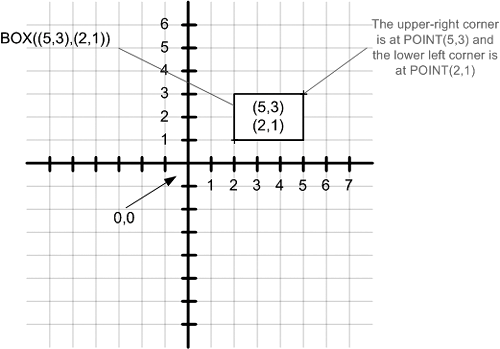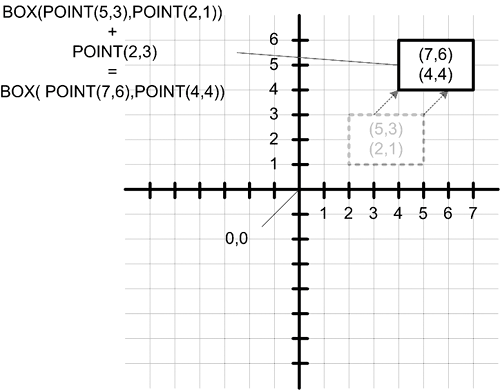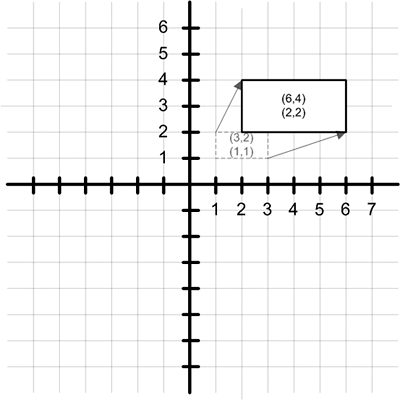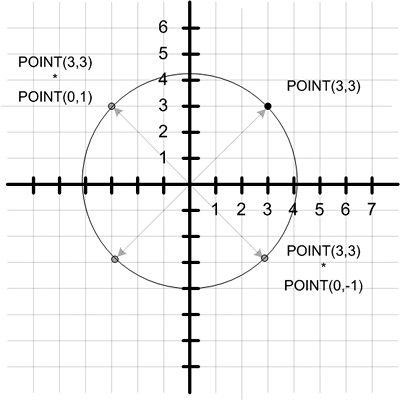Geometric Data Types
PostgreSQL supports six data types that represent two-dimensional geometric objects. The most basic geometric data type is the POINT as you might expect, a POINT represents a point within a two-dimensional plane.
A POINT is composed of an x-coordinate and a y-coordinateeach coordinate is a DOUBLE PRECISION number.
The LSEG data type represents a two-dimensional line segment. When you create a LSEG value, you specify two pointsthe starting POINT and the ending POINT.
A BOX value is used to define a rectanglethe two points that define a box specify opposite corners.
A PATH is a collection of an arbitrary number of POINT s that are connected. A PATH can specify either a closed path or an open path. In a closed path, the beginning and ending points are considered to be connected, and in an open path, the first and last points are not connected. PostgreSQL provides two functions to force a PATH to be either open or closed: POPEN() and PCLOSE(). You can also specify whether a PATH is open or closed using special literal syntax (described later).
A POLYGON is similar to a closed PATH. The difference between the two types is in the supporting functions.
A center POINT and a (DOUBLE PRECISION) floating-point radius represent a CIRCLE.
Table 2.18 summarizes the geometric data types.
|
Type |
Meaning |
Defined By |
|---|---|---|
|
POINT |
2D point on a plane |
x- and y-coordinates |
|
LSEG |
Line segment |
Two points |
|
BOX |
Rectangle |
Two points |
|
PATH |
Open or closed path |
n points |
|
POLYGON |
Polygon |
n points |
|
CIRCLE |
Circle |
Center point and radius |
Syntax for Literal Values
When you enter a value for geometric data type, keep in mind that you are working with a list of two-dimensional points (except in the case of a CIRCLE, where you are working with a POINT and a radius).
A single POINT can be entered in either of the following two forms:
'( x, y )' ' x, y '
The LSEG and BOX types are constructed from a pair of POINT s. You can enter a pair of POINT s in any of the following formats:
'(( x1, y1 ), ( x2, y2 ))' '( x1, y1 ), ( x2, y2 )' 'x1, y1, x2, y2'
The PATH and POLYGON types are constructed from a list of one or more POINT s. Any of the following forms is acceptable for a PATH or POLYGON literal:
'(( x1, y1 ), ..., ( xn, yn ))' '( x1, y1 ), ..., ( xn, yn )' '( x1, y1, ..., xn, yn )' 'x1, y1, ..., xn, yn'
You can also use the syntax '[( x1, y1 ), ..., ( xn, yn )]' to enter a PATH literal. A PATH entered in this form is considered to be an open PATH.
A CIRCLE is described by a central point and a floating point radius. You can enter a CIRCLE in any of the following forms:
'< ( x, y ), r >' '(( x, y ), r )' '( x, y ), r' 'x, y, r'
Notice that the surrounding single quotes are required around all geometric literalsin other words, geometric literals are entered as string literals. If you want to create a geometric value from individual components, you will have to use a geometric conversion function. For example, if you want to create a POINT value from the results of some computation, you would use:
POINT( 4, 3*height )
The POINT( DOUBLE PRECISION x, DOUBLE PRECISION y ) function creates a POINT value from two DOUBLE PRECISION values. There are similar functions that you can use to create any geometric type starting from individual components. Table 2.19 lists the conversion functions for geometric types.
|
Result Type |
Meaning |
|---|---|
|
POINT |
POINT( DOUBLE PRECISION x, DOUBLE PRECISION y ) |
|
LSEG |
LSEG( POINT p1, POINT p2 ) |
|
BOX |
BOX( POINT p1, POINT p2 ) |
|
PATH |
PATH( POLYGON poly ) |
|
POLYGON |
POLYGON( PATH path ) POLYGON( BOX b ) yields a 12-point polygon POLYGON( CIRCLE c ) yields a 12-point polygon POLYGON( INTEGER n, CIRCLE c ) yields an n point polygon |
|
CIRCLE |
CIRCLE( BOX b ) CIRCLE( POINT radius, DOUBLE PRECISION point ) |
Sizes and Valid Values
Table 2.20 lists the size of each geometric data type.
|
Type |
Size (in bytes) |
|---|---|
|
POINT |
16 (2 * sizeof DOUBLE PRECISION) |
|
LSEG |
32 (2 * sizeof POINT) |
|
BOX |
32 (2 * sizeof POINT) |
|
PATH |
4+(32*number of points)[4] |
|
POLYGON |
4+(32*number of points)[4] |
|
CIRCLE |
24 (sizeof POINT + sizeof DOUBLE PRECISION) |
[4] The size of a PATH or POLYGON is equal to 4 + ( size of LSEG * number of segments).
Supported Operators
PostgreSQL features a large collection of operators that work with the geometric data types. I've divided the geometric operators into two broad categories (transformation and proximity) to make it a little easier to talk about them.
Using the transformation operators, you can translate, rotate, and scale geometric objects. The + and - operators translate a geometric object to a new location. Consider Figure 2.1, which shows a BOX defined as BOX( POINT( 3,5 ), POINT( 1,2 )).
Figure 2.1. BOX( POINT( 3,5 ), POINT( 1,2 )).

If you use the + operator to add the POINT( 2,1 ) to this BOX, you end up with the object shown in Figure 2.2.
Figure 2.2. Geometric translation.

You can see that the x-coordinate of the POINT is added to each of the x-coordinates in the BOX, and the y-coordinate of the POINT is added to the y-coordinates in the BOX. The - operator works in a similar fashion: the x-coordinate of the POINT is subtracted from the x-coordinates of the BOX, and the y-coordinate of the POINT is subtracted from each y-coordinate in the BOX.
Using the + and - operators, you can move a POINT, BOX, PATH, or CIRCLE to a new location. In each case, the x-coordinate in the second operand (a POINT), is added or subtracted from each x-coordinate in the first operand, and the y-coordinate in the second operand is added or subtracted from each y-coordinate in the first operand.
The multiplication and division operators ( * and /) are used to scale and rotate. The multiplication and division operators treat the operands as points in the complex plane. Let's look at some examples.
Figure 2.3 shows the result of multiplying BOX(POINT(3,2),POINT(1,1)) by POINT(2,0).
Figure 2.3. Point multiplication-scaling by a positive value.

You can see that each coordinate in the original box is multiplied by the x-coordinate of the point, resulting in BOX(POINT(6,4),POINT(2,2)). If you had multiplied the box by POINT(0.5,0), you would have ended up with BOX(POINT(1.5,1),POINT(0.5,0.5)). So the effect of multiplying an object by POINT(x,0) is that each coordinate in the object moves away from the origin by a factor x. If x is negative, the coordinates move to the other side of the origin, as shown in Figure 2.4.
Figure 2.4. Point multiplication-scaling by a negative value.

The x-coordinate controls scaling. The y-coordinate controls rotation. When you multiply any given geometric object by POINT(0,y), each point in the object is rotated around the origin. When y is equal to 1, each point is rotated counterclockwise by 90° about the origin. When y is equal to 1, each point is rotated 90° about the origin (or 270°). When you rotate a point without scaling, the length of the line segment drawn between the point and origin remains constant, as shown in Figure 2.5.
Figure 2.5. Point multiplication-rotation.

You can combine rotation and scaling into the same operation by specifying non-zero values for both the x- and y-coordinates. For more information on using complex numbers to represent geometric points, see http://www.clarku.edu/~djoyce/complex.
Table 2.21 shows the valid combinations for geometric types and geometric operators.
|
Data Types |
Valid Operators (q) |
|---|---|
|
POINT q POINT |
* + - / |
|
BOX q POINT |
* + - / |
|
PATH q POINT |
* + - / |
|
CIRCLE q POINT |
* + - / |
The proximity operators allow you to determine the spatial relationships between two geometric objects.
First, let's look at the three containment operators. The ~ operator evaluates to TRUE if the left operand contains the right operand. The @ operator evaluates to TRUE if the left operand is contained within the right operand. The ~= returns trUE if the left operand is the same as the right operandtwo geographic objects are considered identical if the points that define the objects are identical (two circles are considered identical if the radii and center points are the same).
The next two operators are used to determine the distance between two geometric objects.
The ## operator returns the closest point between two objects. You can use the ## operator with the following operand types shown in Table 2.22.
|
Operator |
Description |
|---|---|
|
LSEG a ## BOX b |
Returns the point in BOX b that is closest to LSEG a |
|
LSEG a ## LSEG b |
Returns the point in LSEG b that is closest to LSEG a |
|
POINT a ## BOX b |
Returns the point in BOX b that is closest to POINT a |
|
POINT a ## LSEG b |
Returns the point in LSEG b that is closest to POINT a |
The distance (<->) operator returns (as a DOUBLE PRECISION number) the distance between two geometric objects. You can use the distance operator with the operand types in Table 2.23.
|
Operator |
Description (or Formula) |
|---|---|
|
BOX a <-> BOX b |
(@@ BOX a) <-> (@@ BOX b) |
|
CIRCLE a <-> CIRCLE b |
(@@ CIRCLE a) <-> (@@ CIRCLE b) - (radius a + radius b) |
|
CIRCLE a <-> POLYGON b |
-0 if any point in POLYGON b is inside CIRCLE a otherwise, distance between center of CIRCLE a and closest point in POLYGON b |
|
LSEG a <-> BOX b |
(LSEG ## BOX) <-> (LSEG ## (LSEG ## BOX)) |
|
LSEG a <-> LSEG b |
Distance between closest points (0 if LSEG a intersects LSEG b) |
|
PATH a <-> PATH b |
Distance between closest points |
|
POINT a <-> BOX b |
POINT a <-> (POINT a ## BOX b ) |
|
POINT a <-> CIRCLE b |
POINT a <-> ((@@ CIRCLE b) - CIRCLE b radius) |
|
POINT a <-> LSEG b |
POINT a <-> (POINT a ## LSEG b) |
|
POINT a <-> PATH b |
Distance between POINT a and closest points |
|
POINT a <-> POINT b |
-SQRT(( POINT a.x - POINT b.x ) 2 + (POINT a.y - POINT b.y ) 2 ) |
Next, you can determine the spatial relationships between two objects using the left-of (<<), right-of(>>), below (<^), and above (>^) operators.
There are three overlap operators. && evaluates to trUE if the left operand overlaps the right operand. The &> operator evaluates to trUE if the leftmost point in the first operand is left of the rightmost point in the second operand. The &< evaluates to TRUE if the rightmost point in the first operand is right of the leftmost point in the second operand.
The intersection operator (#) returns the intersecting points of two objects. You can find the intersection of two BOX es, or the intersection of two LSEG s. The intersection of two BOX es evaluates to a BOX. The intersection of two LSEG s evaluates to a single POINT.
Finally, the q# operator evaluates to trUE if the first operand intersects with or overlaps the second operand.
The final set of geometric operators determines the relationship between a line segment and an axis, or the relationship between two line segments.
The q- operator evaluates to trUE if the given line segment is horizontal (that is, parallel to the x-axis). The q| operator evaluates to trUE if the given line segment is vertical (that is, parallel to the y-axis). When you use the q- and q| operators with a line segment, they function as prefix unary operators. You can also use the q- and q| operators as infix binary operators (meaning that the operator appears between two values), in which case they operate as if you specified two points on a line segment.
The q-| operator evaluates to trUE if the two operands are perpendicular. The q|| operator evaluates to trUE if the two operands are parallel. The perpendicular and parallel operators can be used only with values of type LSEG.
The final geometric operator (@@) returns the center point of an LSEG, PATH, BOX, POLYGON, or CIRCLE.
Tables 2.24 summarizes the proximity operators.
|
Data Types |
Valid Operators (q) |
|---|---|
|
POINT q POINT |
<-> << <^ >> >^ q- q| @ |
|
POINT q LSEG |
## <-> @ |
|
POINT q BOX |
## <-> @ |
|
POINT q PATH |
<-> @ |
|
POINT q POLYGON |
@ |
|
POINT q CIRCLE |
<-> @ |
|
LSEG q LSEG |
# ## < <-> <= <> = > >= q# q-| q|| |
|
LSEG q BOX |
## <-> q# @ |
|
BOX q POINT |
* + - / |
|
BOX q BOX |
# && &< &> < <-> << <= <^ = > >= >> >^ q# @ ~ ~= |
|
PATH q POINT |
* + - / ~ |
|
PATH q PATH |
+ < <-> <= = > >= q# |
|
POLYGON q POINT |
~ |
|
POLYGON q POLYGON |
&& &< &> <-> >> << @ ~ ~= |
|
CIRCLE q POINT |
* + - / ~ |
|
CIRCLE q POLYGON |
<-> |
|
CIRCLE q CIRCLE |
&& &< &> > <-> << <= <> <^ = > >= >> >^ @ ~ ~= |
Table 2.25 summarizes the names of the proximity operators for geometric types.
|
Data Types |
Valid Operators (q) |
|---|---|
|
# |
Intersection or point count(for polygons) |
|
## |
Point of closest proximity |
|
<-> |
Distance between |
|
<< |
Left of q |
|
>> |
Right of q |
|
<^ |
Below q |
|
>^ |
Above q |
|
&& |
Overlaps |
|
&> |
Overlaps to left |
|
&< |
Overlaps to right |
|
q# |
Intersects or overlaps |
|
@ |
Contained in |
|
~ |
Contains |
|
~= |
Same as |
|
q- |
Horizontal |
|
q| |
Vertical |
|
q-| |
Perpendicular |
|
q|| |
Parallel |
|
@@ |
Center |
Part I: General PostgreSQL Use
Introduction to PostgreSQL and SQL
- Introduction to PostgreSQL and SQL
- A Sample Database
- Basic Database Terminology
- Prerequisites
- Connecting to a Database
- Creating Tables
- Viewing Table Descriptions
- Adding New Records to a Table
- Installing the Sample Database
- Retrieving Data from the Sample Database
- The CASE Expression
- Aggregates
- Multi-Table Joins
- UPDATE
- DELETE
- A (Very) Short Introduction to Transaction Processing
- Creating New Tables Using CREATE TABLE...AS
- Using VIEW
- Summary
Working with Data in PostgreSQL
- Working with Data in PostgreSQL
- NULL Values
- Character Values
- Numeric Values
- Date/Time Values
- Boolean (Logical) Values
- Geometric Data Types
- Object IDs (OID)
- BLOBs
- Network Address Data Types
- Sequences
- Arrays
- Column Constraints
- Expression Evaluation and Type Conversion
- Creating Your Own Data Types
- Summary
PostgreSQL SQL Syntax and Use
- PostgreSQL SQL Syntax and Use
- PostgreSQL Naming Rules
- Creating, Destroying, and Viewing Databases
- Creating New Tables
- Adding Indexes to a Table
- Getting Information About Databases and Tables
- Transaction Processing
- Summary
Performance
- Performance
- How PostgreSQL Organizes Data
- Gathering Performance Information
- Understanding How PostgreSQL Executes a Query
- Execution Plans Generated by the Planner
- The ARC Buffer Manager
- Table Statistics
- Performance Tips
Part II: Programming with PostgreSQL
Introduction to PostgreSQL Programming
- Introduction to PostgreSQL Programming
- Server-Side Programming
- Client-Side APIs
- General Structure of Client Applications
- Choosing an Application Environment
- Summary
Extending PostgreSQL
- Extending PostgreSQL
- Extending the PostgreSQL Server with Custom Functions
- Returning Multiple Values from an Extension Function
- The PostgreSQL SRF Interface
- Returning Complete Rows from an Extension Function
- Extending the PostgreSQL Server with Custom Data Types
- Internal and External Forms
- Defining a Simple Data Type in PostgreSQL
- Defining the Data Type in C
- Defining the Input and Output Functions in C
- Defining the Input and Output Functions in PostgreSQL
- Defining the Data Type in PostgreSQL
- Indexing Custom Data Types
- Summary
PL/pgSQL
- PL/pgSQL
- Installing PL/pgSQL
- Language Structure
- Function Body
- Cursors
- Triggers
- Polymorphic Functions
- PL/pgSQL and Security
- Summary
The PostgreSQL C APIlibpq
- The PostgreSQL C APIlibpq
- Prerequisites
- Client 1Connecting to the Server
- Client 2Adding Error Checking
- Client 3Simple ProcessingPQexec() and PQprint()
- Client 4An Interactive Query Processor
- Summary
A Simpler C APIlibpgeasy
- A Simpler C APIlibpgeasy
- Prerequisites
- Client 1Connecting to the Server
- Client 2Adding Error Checking
- Client 3Processing Queries
- Client 4An Interactive Query Processor
- Summary
The New PostgreSQL C++ APIlibpqxx
- The New PostgreSQL C++ APIlibpqxx
- Prerequisites
- Client 1Connecting to the Server
- Client 2Adding Error Checking
- Client 3Processing Queries
- Client 4Working with transactors
- Summary
Embedding SQL Commands in C Programsecpg
- Embedding SQL Commands in C Programsecpg
- Prerequisites
- Client 1Connecting to the Server
- Client 2Adding Error Checking
- Client 3Processing SQL Commands
- Client 4An Interactive Query Processor
- Summary
Using PostgreSQL from an ODBC Client Application
- Using PostgreSQL from an ODBC Client Application
- ODBC Architecture Overview
- Prerequisites
- Client 1Connecting to the Server
- Client 2Adding Error Checking
- Client 3Processing Queries
- Client 4An Interactive Query Processor
- Summary
- Resources
Using PostgreSQL from a Java Client Application
- Using PostgreSQL from a Java Client Application
- JDBC Architecture Overview
- Prerequisites
- Client 1Connecting to the Server
- Client 2Adding Error Checking
- Client 3Processing Queries
- Client 4An Interactive Query Processor
- Summary
Using PostgreSQL with Perl
- Using PostgreSQL with Perl
- DBI Architecture Overview
- Prerequisites
- Client 1Connecting to the Server
- Client 2Adding Error Checking
- Client 3Processing Queries
- Client 4An Interactive Query Processor
- Summary
Using PostgreSQL with PHP
- Using PostgreSQL with PHP
- PHP Architecture Overview
- Prerequisites
- Client 1Connecting to the Server
- Client 2Adding Error Checking
- Client 3Query Processing
- Client 4An Interactive Query Processor
- Other Features
- Summary
Using PostgreSQL with Tcl and Tcl/Tk
- Using PostgreSQL with Tcl and Tcl/Tk
- Prerequisites
- Client 1Connecting to the Server
- Client 2Query Processing
- Client 3An Interactive Query Processor
- The libpgtcl Large-Object API
- Summary
Using PostgreSQL with Python
- Using PostgreSQL with Python
- Python/PostgreSQL Interface Architecture
- Prerequisites
- Client 1Connecting to the Server
- Client 2Adding Error Checking
- Client 3Query Processing
- Client 4An Interactive Command Processor
- Summary
Npgsql: The .NET Data Provider
- Npgsql: The .NET Data Provider
- Prerequisites
- Preparing Visual Studio
- Understanding the ADO.NET Class Hierarchy
- Creating an Npgsql-enabled VB Project
- Client 1Connecting to the Server
- Client 2An Interactive Query Processor
- Client 3Updating the Database with a DataSet
- Client 4A More Robust Query Processor
- Client 5Using a Typed DataSet
- Summary
Other Useful Programming Tools
- Other Useful Programming Tools
- PL/JavaWriting Stored Procedures in Java
- pgcurlWeb-enabling Your PostgreSQL Server
- pgbashWriting PostgreSQL-enabled Shell Scripts
Part III: PostgreSQL Administration
Introduction to PostgreSQL Administration
- Introduction to PostgreSQL Administration
- Security
- User Accounts
- Backup and Restore
- Server Startup and Shutdown
- Running PostgreSQL on a Windows Host
- Tuning
- Installing Updates
- Localization
- Summary
PostgreSQL Administration
- PostgreSQL Administration
- Roadmap (Wheres All My Stuff?)
- Installing PostgreSQL
- Managing Databases
- The PostgreSQL BGWRITER process
- Managing User Accounts
- Configuring Your PostgreSQL Runtime Environment
- Arranging for PostgreSQL Startup and Shutdown
- Backing Up and Copying Databases
- Point-in-time Recovery
- Summary
Internationalization and Localization
Security
- Security
- Securing the PostgreSQL Data Files
- Securing Network Access
- Securing Tables
- Securing Functions
- Summary
Replicating PostgreSQL Data with Slony
- Replicating PostgreSQL Data with Slony
- Overview
- Requirements
- Creating a Replication Cluster
- Starting the Replication Daemons
- Creating a Replication Set
- Subscribing to a Replication Set
- Changing the Cluster Topology (Re-mastering and Failover)
- Summary
Contributed Modules
Index
EAN: N/A
Pages: 261
